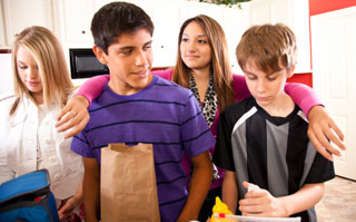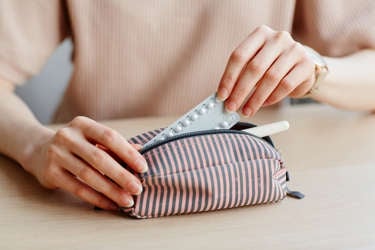
What is phosphorus?
Phosphorus is a mineral found in foods such as milk and milk products. It works with calcium and vitamin D to keep your bones strong and healthy.
Phosphorus and the kidneys
Although phosphorus is needed to keep your body healthy, too much can be dangerous. One of the jobs of the kidneys is to get rid of extra phosphorus in your blood. When the level of phosphorus in your blood is too high, calcium is drawn out of your bones, which can make them weaker.
Keeping your phosphorus levels in a normal range
There are two ways to change the amount of phosphorus in your blood: diet (what you eat) and medicines.
Diet
All foods contain phosphorus. To have less phosphorus in your diet, you simply need to eat fewer foods that are high in phosphorus. This way, you can control the amount of phosphorous your kidneys need to remove and reduce the phosphorus levels in your blood.
Medicines
Some medicines make it harder for phosphorus to reach the kidneys. These medicines act like sponges and soak up phosphorus in food while it is in the stomach. They are called phosphate binders. To work properly, these medicines must be taken with meals and snacks.
Read food labels
Some food labels will show the amount of phosphorus in a food. But remember that even if phosphorus is not marked on the label, it may still be in the food.
Fast food and processed foods (such as chicken fingers or boxed macaroni and cheese) are very high in phosphorus because they contain high amounts of phosphate additives. Here is a list of additives to watch for.
| Phosphate additives in fast foods | |
|---|---|
| Phosphoric acid | Sodium polyphosphate |
| Pyrophosphate | Sodium tripolyphosphate |
| Polyphosphate | Tricalcium phosphate |
| Hexametaphosphate | Trisodium phosphate |
| Dicalcium phosphate | Sodium phosphate |
| Monocalcium phosphate | Tetrasodium phosphate |
| Aluminium phosphate | |
Choose foods that have less than 100 mg of phosphorus per serving.
| Food labels: Nutrition Facts (one serving) | ||
|---|---|---|
| Amount | % Daily Value | |
| Phosphorus | Less than 100 mg | 10% or less |
Low-phosphorous food choices
Vegetables and fruit
| Best choices | Foods to avoid |
|---|---|
| Plain vegetables and fruit | Vegetable dishes made with cream or cheese sauces |
| Coconut water | Coconut milk; coconut flesh |
| Limit: avocado, asparagus, corn, lotus root, mushrooms, peas, bean sprouts, artichoke, heart of palm, potato, figs, jujube, longan, lychee, dry peaches, tamarind | |
If you on a low-potassium diet, speak to your dietitian for further food choice tips.
Breads and cereals
| Best choices | Foods to avoid |
|---|---|
| White bread, light rye bread, Italian and French breads | Whole wheat bread or scones, bran, dark rye bread, soda bread, multigrain bread, corn bread, pumpernickel bread |
| White English muffins, white plain bagels, white rolls, croissants, brioche, crumpets | Whole wheat English muffins, whole wheat bagels, whole wheat rolls |
| Chapatti, roti, challah, pittu, pita, tortilla, papseco made with white wheat or rice flour | Chapati, roti, pittu, pita, tortilla, papseco made with whole wheat flour |
| Crackers made with white flour | Crackers made with whole wheat flour (brands include Wheat Thins, Bretons, Triscuit) |
| Rice crackers, Crispers, matzo, graham crackers, rusk toast, soda crackers, Ritz regular, vegetable crackers (such as Vegetable Thins) | Ritz Bits sandwiches made with cheese or peanut butter |
| Cereals: cream of rice, cream of wheat, puffed rice and wheat, corn-based (brands include Corn Flakes, Corn Pops, Corn Chex, Crispix, Froot Loops, Frosted Flakes, Honey Bunches, Honeycomb, Just Right, Rice Krispies, Rice Chex, Special K, Alphabits, Reese Puffs, Sugar Crisp, Golden Grahams, Magix, Trix, Cap'n Crunch) | Cereals: bran cereals (such as All-Bran, Bran Flakes, Raisin Bran), whole grain cereals (such as Life, Shreddies, Cheerios, Honey Nut Cheerios, Vive, Vector, Mueslix, Cinnamon Toast Crunch); oat cereals, porridge, instant oatmeal; cereal with dried fruits, raisins or nuts |
| White pastas, rice noodles, egg noodles | Whole wheat pasta, macaroni and cheese |
| White rice | Brown or wild rice |
| Couscous, quinoa, soba, hominy, barley | Buckwheat, bulgur, wheat germ |
| Homemade pancakes, waffles, biscuits, French toast (1 medium) | Store-bought biscuit mixes, waffles, pancakes |
| Flour made from quinoa, soy, corn (cornmeal, masa), chickpeas, barley, brown rice, rye or whole wheat | |
| Cookies, cakes, muffins, donuts or pastries containing whole wheat flour, bran, peanut butter, molasses, nuts, seeds, raisins, cinnamon, caramel or chocolate (brands include Chocolate Twinkie, Swiss Cake Rolls, Wagon Wheels) |
Milk and alternatives
| Best choices | Foods to avoid |
|---|---|
| Rice, almond or soy drink, unsweetened and not fortified with calcium (brands include Rice Dream, Almond Breeze, SoNice natural, VitaSoy vanilla delight) | Cow's milk (homogenized, 3.2%, 2%, 1% or skim); goat milk; fortified soy or rice drinks |
| Cream cheese, brie, bocconcini, soft goat cheese, Romano or Parmesan cheese (max 2 tablespoons a day) | All other cheeses, including all processed cheese |
| Rice Dream frozen dessert | Pudding, custard, flan, rice pudding |
| Non-dairy whipped topping; whipped or sour cream (max 2 tablespoons a day) | Yogurt; frozen yogurt |
| Sherbet | Ice cream; ice cream bars |
Meat and meat alternatives
| Best choices | Foods to avoid |
|---|---|
| Meat and poultry such as beef, pork, lamb, chicken, turkey, duck, goat, veal | Organ meats such as kidney, liver, heart |
| Luncheon meats; hot dogs | Sausages, bologna, luncheon meat packaged with crackers and cheese (such as Lunchables or Lunchmates) |
| Cod, snapper, haddock, bass, trout | Fish eggs (fish roe, caviar), smelt, carp, flounder |
| Shrimp, lobster, squid (calamari), crab | Clams, oysters, mussels |
| Canned tuna and salmon, drained, with bones removed | Canned salmon or sardines with bones included |
| Soft tofu | Firm tofu |
| Egg whites (up to three whites a day); egg subsitute (such as Naturegg) | Whole eggs |
| Chestnuts, macadamia nuts, pecans (1/4 cup or about 50 grams) | All other nuts; all seeds; trail mix |
| Peanut butter (up to 1 tablespoon a day) | Chocolate/hazelnut spread (such as Nutella) |
| Peas, beans, chickpeas, lentils (canned or dry); dal; hummus; baked beans; pork and beans |
Drinks
| Best choices | Foods to avoid |
|---|---|
| Light tea | Strong coffee or tea |
| Non-dairy creamers (brands include Coffee Rich or Coffee Mate) | Drinks made with milk, buttermilk, coconut milk, chocolate milk, malted milk |
| Popsicles | Sports drinks such as Gatorade |
| Non-cola soft drinks or pop such as Sprite, ginger ale and root beer | Cola soft drinks or pop |
| Beverages made without phosphorus additives (such as some iced teas and Kool-Aid) | Chocolate- and malt-based drinks such as hot chocolate, Milo, Horlicks and Ovaltine; coffee substitutes such as Postum and Caflib |
| Fruit juices* | Beer |
*Avoid grapefruit juice.
Snacks
| Best choices | Foods to avoid |
|---|---|
| Hot dogs; plain burger | Cheeseburgers; fish sandwiches with cheese; tacos and burritos (all kinds); pizza |
| Popcorn, corn or tortilla chips, rice cakes, Goldfish, Ritz crackers, pretzels | Potato chips; nuts and seeds; nachos with cheese |
| Spring rolls with shrimp or vegetables | Egg rolls; falafel |
| Brownies, cheesecake | |
| Chocolate (chips, bars, candies, drinks, desserts) | |
| Fruit juices* | Beer |
*Avoid grapefruit juice.






